Publication history
In 1866, Louisa May Alcott toured Europe for the first time; being poor, she traveled as the paid companion of an invalid. [1] Upon her return, she found her family in financial straits; subsequently, when publisher James R. Elliot asked her to write another novel suitable for serialisation in the magazine The Flag of Our Union (later mockingly referred to as "The Weekly Volcano" in Little Women), [2] Alcott dashed off a 292-page Gothic romance entitled A Modern Mephistopheles, or The Fatal Love Chase as a potboiler. She gave the novel a European setting and incorporated many of her still-fresh travel experiences and observations, but Elliot rejected it for being "too long & too sensational!", [3] whereupon she changed the title to Fair Rosamond and undertook extensive revisions to shorten the novel and tone down its more controversial elements. Despite these changes, the book was again rejected, and Alcott laid the manuscript aside.
Fair Rosamond ended up in Harvard's Houghton Library. [4] The earlier draft was auctioned off by Alcott's heirs and eventually fell into the hands of a Manhattan rare book dealer. In 1994, Kent Bicknell, headmaster of the Sant Bani School in Sanbornton, New Hampshire, paid "more than his annual salary but less than $50,000" for the unexpurgated version of the manuscript. After restoring it, he sold the publication rights to Random House, receiving a $1.5 million advance. Bicknell donated 25% of the profits to Orchard House (the museum of the Alcott Family), 25% to the Alcott heirs, and 25% to the Sant Bani School. [5]
In 1995, Random House released the novel in a hardbound edition under the title A Long Fatal Love Chase. It became a best-seller, and an audiobook version soon followed. The novel is still in print (September 2007) as a trade paperback from Dell Books. [6]
Plot summary
Rosamond Vivian, a discontented maiden who lives on an English island with only her bitter old grandfather for company, begins the novel by rashly declaring: "I often feel as if I'd gladly sell my soul to Satan for a year of freedom." Right on cue, a man named Phillip Tempest, a libertine who intentionally bears a more than trivial resemblance to Mephistopheles, makes contact with Rosamond. Within a month, Rosamond is in love with him, and although she realizes that this man is "no saint", she marries him, believing with the fatuousness of youth that her love will save him. She sails away from her lonely island in Tempest's yacht, the Circe, and begins her married life at a luxurious villa in Nice.
Much to his own surprise, Tempest, an otherwise cold and heartless man, finds that he is content with the relationship. He tries to make Rosamond happy, and succeeds for a while; however, after a year in his company, she realizes how conscienceless and cruel he is, and discovers that Tempest has a wife and son already, making their marriage a sham and Rosamond the unwitting mistress of a man who has grossly deceived her. On the same night, she packs up, stealthily climbs down from her second-floor balcony, and catches the next train to Paris. Tempest aggressively pursues and stalks her, beginning the obsessive "chase" of the title.
Tempest continues to hunt and torment Rosamond, repeatedly signalling to her that he enjoys the pursuit and pressuring her to return to him. To attempt to avoid him, she assumes a variety of disguises: in Paris, she is a seamstress named "Ruth"; next, she escapes to a convent, where she is known as "Sister Agatha"; after that, under the name "Rosalie Varian", she travels to Germany as a nameless companion to a wealthy little girl.
Each time, as she begins to settle comfortably into a new life, Tempest reappears and attempts to recommence the relationship, which has become far more perilous than before. Under this treatment, Rosamond learns to hate and fear her former lover. At the same time, a hopeless passion develops between Rosamond and Father Ignatius, a handsome, virtuous, high-born man who happens, unfortunately, to be a Roman Catholic priest. The chase finally, and tragically, ends on the night Ignatius attempts to help Rosamond return to her grandfather's island.
Critical reception
Although Alcott wrote the novel hastily while under considerable economic pressure and submitted it under the name “A. M. Barnard” — a pseudonym she used for several other Gothic thrillers — Love Chase received good mainstream reviews in 1995, 129 years after its intended appearance as an ephemeral potboiler.
Most contemporary critics choose to emphasize the strong feminist elements, fast-moving story, curiously contemporary “stalker” theme, and — most of all — the conspicuous lack of domesticity (in contrast with Little Women). [7] [8] The Booklist reviewer declares “Alcott's melodramatic but intriguing tale dramatises the tragic plight of women in her oppressive times“, [9] while Katherine Powers of Forbes , exclaiming over the novel's unexpectedly exuberant violation of norms, recommends the audiobook version as “a real Gothic potboiler by a slumming Louisa May Alcott”. [10] Phoebe-Lou Adams of the Atlantic Monthly , wondering why such an exciting and adjective-rich narrative was originally rejected, speculates “Could the objection have been simply that the heroine, on discovering that she has been duped into a false marriage with a murderer, fails to collapse and die of shame? Instead she scoops up the available jewels, flees by night through a window, and repudiates any guilt in the affair. Perfectly sensible of her–but perhaps not what readers of Victorian light literature were prepared to approve.” [11]
Scholarly importance
Alcott's pseudonymous career as A. M. Barnard, successful writer of sensational fiction, was brought to light in the early 1940s by a rare book dealer, Madeleine B. Stern, and a librarian, Leona Rostenberg. Their discovery became widely known in 1975, when Stern dusted off some of the more interesting stories for Behind a Mask: The Unknown Thrillers of Louisa May Alcott. [12] Since then, several more such collections have been published, providing intriguing new material for literary scholars and biographers eager to reevaluate Alcott's career. The strongly feminist Love Chase seems likely to become a valued resource in this field of inquiry, with the added cachet that it was once judged too sensational for publication. In the words of reviewer Andria Spencer, “What proves so fascinating about Saxton's biography [a 1977 Alcott biography, reissued in 1996], A Long Fatal Love Chase, and … Behind a Mask is the reversal made in addressing Alcott's life and work — the solid, upright pedagogue melts away before the image of the ardent suffragette, sole support of family and home and rebel, despite herself.” [13]
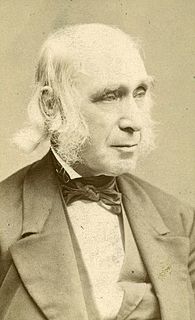
Amos Bronson Alcott was an American teacher, writer, philosopher, and reformer. As an educator, Alcott pioneered new ways of interacting with young students, focusing on a conversational style, and avoided traditional punishment. He hoped to perfect the human spirit and, to that end, advocated a plant-based diet. He was also an abolitionist and an advocate for women's rights.

Louisa May Alcott was an American novelist, short story writer, and poet best known as the author of the novel Little Women (1868) and its sequels Little Men (1871) and Jo's Boys (1886). Raised in New England by her transcendentalist parents, Abigail May and Amos Bronson Alcott, she grew up among many well-known intellectuals of the day, such as Ralph Waldo Emerson, Nathaniel Hawthorne, Henry David Thoreau, and Henry Wadsworth Longfellow.

Little Women is a coming-of-age novel written by American novelist Louisa May Alcott (1832–1888).
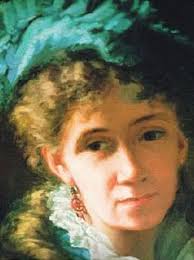
Abigail May Alcott Nieriker was an American artist and the youngest sister of Louisa May Alcott. She was the basis for the character Amy in her sister's semi-autobiographical novel Little Women (1868). She was named after her mother, Abigail May, and first called Abba, then Abby, and finally May, which she asked to be called in November 1863 when in her twenties.
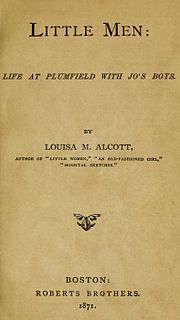
Little Men, or Life at Plumfield with Jo's Boys, is a children's novel by American author Louisa May Alcott (1832–1888), which was first published in 1871 by Roberts Brothers. The book reprises characters from her 1868–69 two-volume novel Little Women, and acts as a sequel, or as the second book in an unofficial Little Women trilogy. The trilogy ends with Alcott's 1886 novel Jo's Boys, and How They Turned Out: A Sequel to Little Men. Alcott's story recounts the life of Jo Bhaer, her husband, and the various children at Plumfield Estate School. Alcott's classic novel has been adapted to a 1934 film, a 1940 film, a 1998 film, a television series, and a Japanese animated television series.
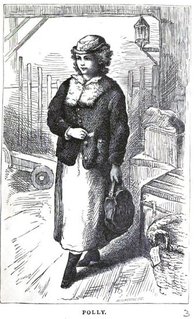
An Old-Fashioned Girl is a novel by Louisa May Alcott first published in 1869.
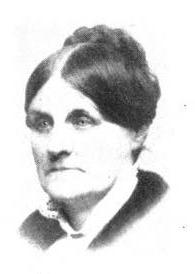
Abigail "Abba" Alcott was an American activist for several causes and one of the first paid social workers in the state of Massachusetts. She was the wife of Transcendentalist Amos Bronson Alcott and mother of four daughters, including Civil War novelist Louisa May Alcott.

Orchard House is a historic house museum in Concord, Massachusetts, United States, opened to the public on May 27, 1912. It was the longtime home of Amos Bronson Alcott (1799–1888) and his family, including his daughter Louisa May Alcott (1832–1888), who wrote and set her novel Little Women (1868–69) there.
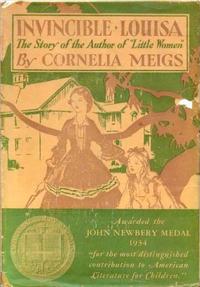
Invincible Louisa is a biography by Cornelia Meigs that won the Newbery Medal and the Lewis Carroll Shelf Award. It retells the life of Louisa May Alcott, author of Little Women.

Eight Cousins, or The Aunt-Hill was published in 1875 by American novelist Louisa May Alcott. It is the story of Rose Campbell, a lonely and sickly girl who has been recently orphaned and must now reside with her maiden great aunts, who are the matriarchs of her wealthy Boston family. When Rose's guardian, Uncle Alec, returns from abroad, he takes over her care. Through his unorthodox theories about child-rearing, she becomes happier and healthier while finding her place in her family of seven boy cousins and numerous aunts and uncles. She also makes friends with Phebe, her aunts' young housemaid, whose cheerful attitude in the face of poverty helps Rose to understand and value her own good fortune.
Anna Bronson Alcott Pratt was the elder sister of American novelist Louisa May Alcott. She was the basis for the character Margaret "Meg" of Little Women (1868), her sister's classic, semi-autobiographical novel.
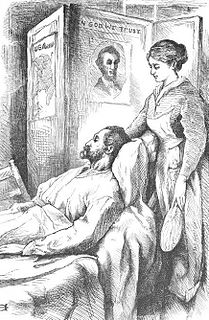
Hospital Sketches (1863) is a compilation of four sketches based on letters Louisa May Alcott sent home during the six weeks she spent as a volunteer nurse for the Union Army during the American Civil War in Georgetown.
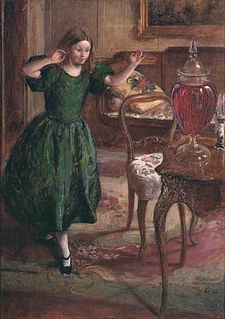
"The Purple Jar" is a well-known short story by Maria Edgeworth (1768-1849), an Anglo-Irish writer of novels and stories. "The Purple Jar" first was published in The Parent's Assistant (1796) and reappeared in Rosamond (1801). Edgeworth's parable of desire and disappointment is now popularly read as the story of a girl getting her first period or menstruation in general.

The Flag of Our Union (est.1846) was a weekly story paper published in Boston, Massachusetts, in the mid-19th century. In addition to news it featured works of fiction and poetry including contributions from notable writers such as Louisa May Alcott and Edgar Allan Poe. Publisher Frederick Gleason began The Flag in 1846, a "miscellaneous family journal, containing news, wit, humor, and romance -- independent of party or sect." Original stories, verse, and illustration appeared in the paper, as well as brief news items on local, national and international current events. Maturin Murray Ballou served as editor. In 1849, Gleason's office was located "on the corner of Court and Tremont Streets" in Boston.

Jane Goodwin Austin was an American writer, notable for her popular stories of the time. During her lifetime, she was the author of 24 books and numerous short stories. Her friends throughout her life were some of the most well-known American authors, including Ralph Waldo Emerson, Nathaniel Hawthorne, and Louisa May Alcott.
Behind a Mask, or A Woman's Power is a novella written by American author Louisa May Alcott. The novella was originally published in 1866 under the pseudonym of A. M. Barnard in The Flag of Our Union. Set in Victorian era Britain, the story follows Jean Muir, the deceitful governess of the wealthy Coventry family. With expert manipulation, Jean Muir obtains the love, respect, and eventually the fortune of the Coventry family.
John Bridge Pratt was the husband of Anna Bronson Alcott Pratt, the elder sister of novelist Louisa May Alcott. He inspired the fictional character John Brooke in his sister-in-law Louisa May Alcott's best known novels.
Madeleine Bettina Stern, born in New York, New York, was an independent scholar and rare book dealer. She graduated from Barnard College in 1932 with a B.A. in English literature. She received her M.A. in English literature from Columbia University in 1934. Stern was particularly known for her work on the writer Louisa May Alcott. She received a Guggenheim Fellowship in 1943 to write a biography of Alcott, which was eventually published in 1950. In 1945, she and her friend Leona Rostenberg opened Rostenberg & Stern Books. Rostenberg and Stern were active members of the Antiquarian Booksellers' Association of America, at a time when few women were members. The pair lived and worked in Rostenberg's house in the Bronx. They were known for creating unique rare book catalogs. In 1960, Stern helped found the New York Antiquarian Book Fair.
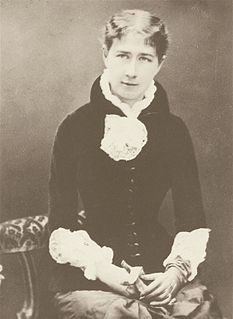
Mary Colman Wheeler was the founder and first head of the Wheeler School in Providence, Rhode Island.
"Lost in a Pyramid; or, The Mummy's Curse" is a short story written by American author Louisa May Alcott and first published by Frank Leslie in 1869. Despite being largely overlooked throughout the twentieth century, "Lost in a Pyramid" was rediscovered in 1998 and has since become an influential example of early "mummy's curse" narratives.
















